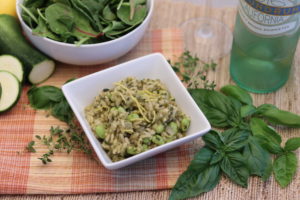 Have you ever noticed how many Eat REAL America recipes call for citrus zest –
Have you ever noticed how many Eat REAL America recipes call for citrus zest –
either lemon, lime or orange zest?
Do you sometimes ask yourself “is that ingredient really necessary?” or do you just skip over it?
If you turn the clock back several years, that was us!
We rarely used citrus zest. To be honest, we really didn’t even know how to add citrus zest to a meal. Eventually, something prompted us to try it and we realized we were literally throwing away phenomenal flavor! And we also realized how easy “zesting” is!
What is citrus zest?
Zest is the grated peel of citrus fruit, typically lemon, lime, orange or grapefruit. When you zest a fruit, you want to make full use of the outer peel. For the best results, you want to avoid the white pith, just under the peel, which can taste bitter.
Why should you zest?
 Two words…flavor and nutrition! Citrus zest adds a great “pop” of flavor to a wide variety of dishes including sauces, dressings, toppings…even desserts and baked goods! The citrus peel contains aromatic oils, which are strongest just after zesting. So, fresh zest is best, but you can also freeze it with good results (see below). Typically, the more fragrant the fruit, the more flavorful the zest will be, so this is another reason to be picky when selecting your fruits.
Two words…flavor and nutrition! Citrus zest adds a great “pop” of flavor to a wide variety of dishes including sauces, dressings, toppings…even desserts and baked goods! The citrus peel contains aromatic oils, which are strongest just after zesting. So, fresh zest is best, but you can also freeze it with good results (see below). Typically, the more fragrant the fruit, the more flavorful the zest will be, so this is another reason to be picky when selecting your fruits.
Not only does citrus zest add great flavor, but it is also loaded with nutrients! Who knew?! There are actually over 60 different types of flavonoids, or antioxidants, in citrus. And, many of the highest concentrations are found in the peels!
For example, 1 Tbsp of lemon peel contains twice the amount of Vitamin C and three times the amount of fiber than you would find in one lemon wedge. One of the oils found in citrus peels is d-limonene, which has shown potential to help prevent and treat certain cancers and also help treat GERD (gastric reflux). More research is needed, but this is another example of the potential health benefits that accompany the wonderful flavor!
How do you zest?
To zest your fruit, simply follow these steps:
1. Wash and dry the fruit before zesting (this will help remove fungicides that are often used on citrus crops).
2. If you have a citrus zester or microplane zester, use it to remove the outer peel from the fruit. If you do not have a zester, you can use a sharp knife to cut off the peel and then finely chop it. Keep in mind, zesting is much easier before you peel or cut the fruit!
3. Add the citrus zest to your recipe and enjoy!
All you really need is a sharp knife, but there are a couple of kitchen tools that will make zesting super-easy and convenient. The microplane zester is our “go-to” – it is so easy to use and we also use it for cheese, chocolate, fresh ginger and so many other things!
Citrus Zester :
:
 this tool will let you make very thin strips of citrus zest, or larger strips of the peel, which is ideal for adding zest to the top of baked goods, or as a garnish in certain dishes.
this tool will let you make very thin strips of citrus zest, or larger strips of the peel, which is ideal for adding zest to the top of baked goods, or as a garnish in certain dishes.
This zester works great for adding zest to these ideas:
Dark Chocolate Bark with Pomegranates and Orange Zest
Grilled Seafood with Summer Melon Salsa
Pasta with Mint, Lemon & Spring Peas
Tuna Lettuce Wraps with Horseradish Dressing
Microplane Zester :
:
 this tool does an excellent job of finely grating the citrus peel. It is easy to use and holds the zest in the tool until you are ready to add it to your recipe.
this tool does an excellent job of finely grating the citrus peel. It is easy to use and holds the zest in the tool until you are ready to add it to your recipe.
This zester is ideal for grating fresh ginger root too!
How do you use zested citrus peel?
Typically, there is 1 Tbsp zest in one orange and 1-2 tsp of zest in one lemon or lime. Once you start zesting, the possibilities are endless!
 Add lemon zest to pasta just before serving for a pop of fresh lemon flavor
Add lemon zest to pasta just before serving for a pop of fresh lemon flavor- Add zest to sauces in the last few minutes of cooking
- Give breadcrumbs an added kick of flavor
- Fresh citrus zest is excellent when added to toppings like chutney, gremolata or aioli
- Add fresh flavor to your homemade dressings
- Impress your guests by adding zest to your favorite drinks like iced teas or other refreshing beverages
Can you freeze zest?
Yes! Citrus zest is typically best when used fresh, but freezing it for later use is also a great option. Just think about how many lemon, lime or orange peels you throw away during the course of a year.
Instead of throwing away all this flavor, make it a habit to use a microplane zester to quickly zest the fruit before you juice it or peel it. You can keep small containers in your freezer…one each for lemon, lime and orange zest. Mason jars and small plastic storage containers work great. Simply add the zest to your container and it is ready to grab and use when you need it. You can also freeze the whole fruit, but in our experience, zesting the fruit before freezing retains the most flavor.
What are some ideas where zest can work its magic?
There are so many, but here are some examples:
 Acorn Squash & Apple Salad
Acorn Squash & Apple Salad- Arugula Salad with Orange Sesame Vinaigrette
- Asian Salmon Cakes
- Baked Parmesan Mushrooms
- Blueberry Lemon Breakfast Cookies
- Broccoli Cabbage Caesar Salad
- Caesar Style Deviled Eggs
- Citrus Grilled Chicken or Shrimp
- Greek Inspired Lamb Tacos
- Herb and Panko Crusted White Fish
- Honey Lime Sriracha Cauliflower
- Mediterranean Inspired Pork Tenderloin
 Roasted Broccoli & Farro Salad
Roasted Broccoli & Farro Salad- Sauteed Squash with Oranges & Pistachios
- Scallops on Creamy Leeks
- Slow Cooker Mango Chicken Stuffed Peppers
- Spaghetti Squash Gremolata
- Spring Vegetable Orzo Pasta Salad
- Springtime Minted Pea Dip
- Summer Stuffed Peppers
- Sweet Potato Quesadillas
- Winter Fruit Salad
Go ahead and try it!
See if you agree that it adds a fantastic pop of fresh flavor!
What are your favorite ways to use citrus zest? Do you have other tips?
Please share with us!
 LEARN MORE ABOUT THE NAPKIN!
LEARN MORE ABOUT THE NAPKIN!




I have in the past used a reamer to juice my lemons after cutting them in half. I toss the half lemons in a freezer bag and into the freezer. If I need to have zest, I take out a frozen lemon rind and zest it as needed. This way the oils are still intact in the peel. When I tried zesting them individually I usually end up tossing them because they have freezer burned, But mostly due to the micro plane zester I have.
Zest is an often underrated ingredient in the kitchen, but the fact that it can impart flavor and even yield health benefits shouldn’t be overlooked. Thanks for sharing!